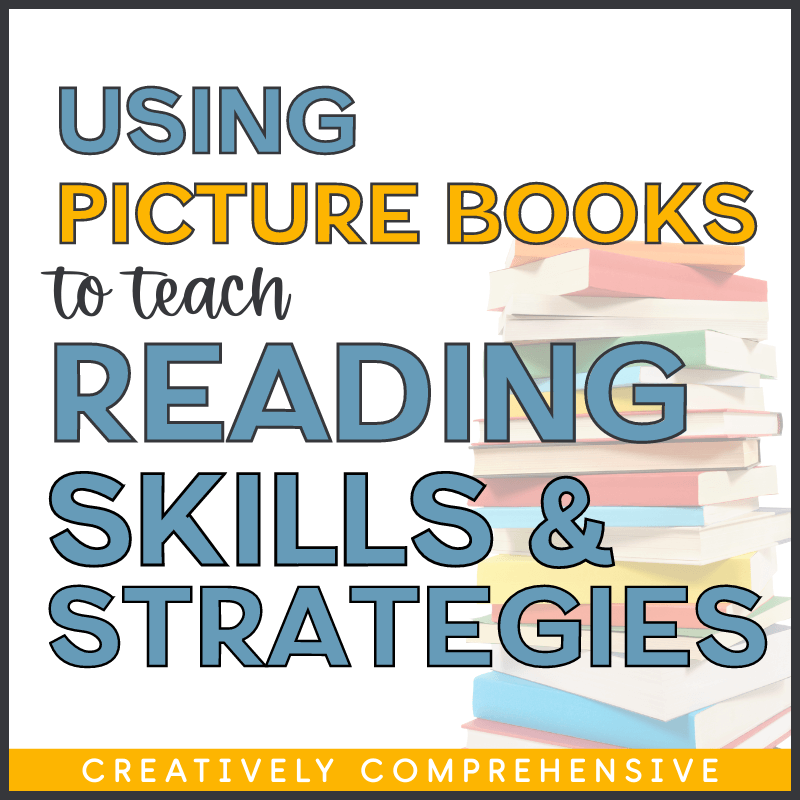Using Picture Books to Teach Reading Strategies!
Picture books are a great way to teach reading skills and strategies to students. They introduce the content of your lesson in an engaging way and give students a foundation they can apply to longer, more challenging texts. Interested in how to get the most out of picture books? This blog post is just for you. In addition, there’s a FREE book list at the bottom of this post with a great selection of books for different skills and strategies!

Why Picture Books?
Picture books are an excellent way to kick off a minilesson for any reading skill or strategy. Here are some reasons why:
– They can be used with students of all ages. Trust me, 4th and 5th graders LOVE picture books!
– They are engaging. Who wants to learn about cause and effect from a workbook page?
– There is a wide range of picture books available on many different topics, which makes it easy to find one that fits your lesson perfectly. (Don’t forget to grab that free list below)!

Tips for Using Picture Books in the Classroom
Here are some tips to make sure you’re getting the most out of picture books in your classroom:
– Think aloud, think aloud, think aloud! We need to model to our students what experienced readers do as they read.
– Use them as a launchpad for discussion and writing. After reading the book, have students brainstorm what they learned about the skill or strategy. Then, have them write about it in their own words. A response menu is an excellent way for students to keep track of their thinking.
– Give students time to explore the book on their own. After the initial read-aloud, put the book in a reading center and let students reread it or read it with a partner. This is an excellent way for them to practice what they’ve learned! I liked to have a designated basket in my classroom library filled with read alouds.

Selecting Books to Introduce Skills and Strategies
Visualizing
Books with detailed descriptions are perfect to jumpstart your lesson about visualization. Have students practice by visualizing what you read without showing them the book illustration. Then, reveal the image and discuss the similarities and differences between their visualization and the illustrator’s artwork!
Main Idea
Look for books with several short paragraphs on each page for a main idea lesson. This will give you plenty of opportunities to model and practice finding the main idea for your students.
Sequencing
When looking for a fiction book for teaching sequencing, you’ll want to find one with a clear beginning, middle, and end. This will help students identify the sequence of events in the story. A great way to extend this lesson is to have students create their own sequence strips using pictures from the book!
Cause and Effect
For cause and effect, you want to look for a book with events that lead naturally to a solution. This could be a problem/solution text structure or a cause/effect text structure. Students can practice identifying the cause and effect relationship by brainstorming a list of events from the story and then categorizing them as cause or effect.
Compare and Contrast
To teach compare and contrast, you’ll want to find a book with two characters or objects with similarities and differences. After reading the book, have students create a Venn diagram to organize their thinking. Then, they can write about what they learned in their own words.
Story Elements
For teaching story elements, you’ll want to find a fiction book with a well-developed plot. This will allow students to identify the different parts of the story, including the setting, characters, problem, and solution. A great way to extend this lesson is to have students create their own story maps!
Fact and Opinion
When looking for a book to teach facts and opinions, you’ll want to find one with clear examples of each. Nonfiction books are a great option, but you can also use fiction books if they contain factual information about the characters or setting. After reading the book, have students sort statements from the story into two categories: fact or opinion.
Text Features
You’ll want to find a nonfiction book with various text features to teach this skill. This could include labels, captions, headings, and diagrams. After reading the book, have students brainstorm what they learned from each text feature. Then, they can write about it in their own words.
Free Book List!
If you’re looking for some great picture books to teach reading skills and strategies, I’ve got you covered! I’ve put together a list of my favorites that you can download for free. Just click the link below and enter your email address to get instant access.
Well, that’s it! Do you have any tried and true favorite picture books for your ELA lessons? Let me know in the comments!
~Marianna
